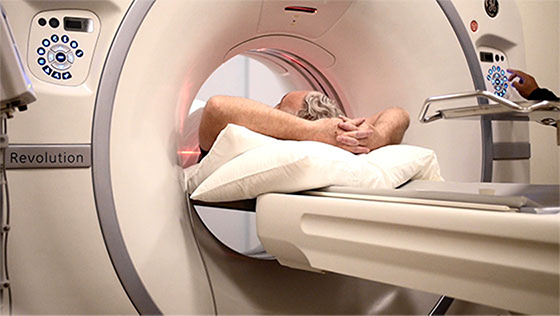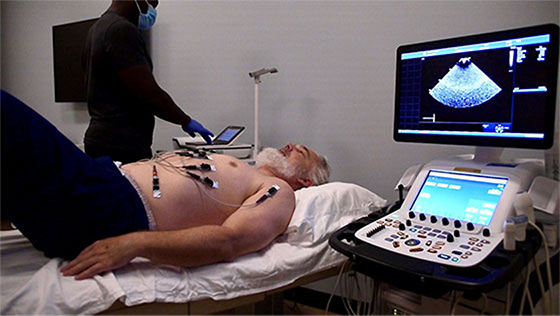Dear Reader,
What good is wealth if we don’t have our health to enjoy it?
That was the question on my mind last August when I traveled to La Jolla, California, to visit a company called Health Nucleus. From my perspective, it’s the future of health care.
What it offers is a lens on the future… not only for our health, but for the future of the industry. It’s a trend known as precision medicine. This is an emerging approach to treat and prevent diseases by considering each person’s genetic makeup, environment, and lifestyle.
In other words, it’s the opposite of what our health care system is today. And it’s a space I knew investors needed to be aware of.
Now, I often travel and engage in “boots on the ground” research for my subscribers. But this time, my research was a bit different. Rather than a company or technology being the focus of my attention, the subject was me.
I flew to San Diego to put myself through tests and diagnostics so that I could deeply understand what the future looks like. I was the one being poked and prodded this time.
And my crazy idea to do so may very well have saved my life…

I first learned about Health Nucleus back in 2014 when genetic sequencing giant Illumina invested in a company called Human Longevity. That’s the parent holding company of Health Nucleus.
Health Nucleus’ mission is straightforward: to evaluate the human condition from head to toe (our phenotype) and compare that to a whole genome sequence – an analysis of all 3.2 billion base pairs of our human DNA.
By doing so, it is possible to map our genetic structure to our current or future conditions.
Why is this so invaluable? It empowers us to understand our risk for disease, what kind of medications we will respond well to, and even medications that would have adverse effects on us due to our genetics.
Knowing these things in advance can be lifesaving. It also empowers us to adjust our lifestyles to avoid a “fate” that we would face down the road.
The goal of my visit was simple, though – to bring my subscribers knowledge they would not otherwise have had. And it just so happens that I got a lot more out of the experience than I expected…
My day at Health Nucleus started with blood… lots of blood. I wasn’t even sure if I would have enough left to make it through the day.
After a fast from the evening before, the first thing that the team does is capture your blood. It is a great way to get a snapshot of what your system looks like on any given day.

But this isn’t the kind of blood test that our family doctor orders to check in on our cholesterol. It’s a completely different approach.
Rather than looking for a specific marker that might explain a symptom or checking if we have influenza A or B (or COVID-19, for that matter), the team at Health Nucleus looks for anything that may reveal something is wrong or even a bit off-kilter.
More than 40 different blood biomarkers are tested for things like kidney and liver function, insulin sensitivity, glucose levels, a detailed cholesterol panel, biomarkers for inflammation, hormones, vitamins, nutrients, heavy metals, prostate-specific antigen (PSA) values, lipids, and more. The analysis even looks at more than 900 metabolites, which is what is left over after the body has metabolized food.
When the results came back, I had nine detailed pages of analysis.
That bloodwork was followed by a full-body magnetic resonance imaging (MRI) scan.
This isn’t something that we would typically ever do. In a normal clinical environment, there would never be a reason to conduct a full-body MRI. Conventional medicine offers no justification for imaging parts of the body with no symptoms. If we are having terrible shoulder pain and can’t lift our arm above our head, the orthopedist orders a shoulder-specific MRI. The doctor will just focus on where the symptom is presenting.
But at Health Nucleus, the goal is to take a very detailed whole-body view to see if anything is of concern. And when I say detailed, I mean it.
The typical MRI that most of us experience uses a 1.5 Tesla (1.5 T) machine. A Tesla is the unit of measurement for the strength of the magnetic field of the MRI scanner. But the full-body MRI scan at Health Nucleus uses a 3 Tesla scanner. As a result, it produces incredibly clear images of our bodies.

The imaging starts with an extremely detailed scan of the brain. The resolution enables the MRI to map out the brain’s blood vessels. The scan can find an aneurysm as small as 3 millimeters in diameter.
(My wife was convinced that they would find something wrong up there… but I proved her wrong and received a glowing readout on my brain scan. Ha!)
After the brain, the process is repeated for the cardiovascular system. The machine takes the equivalent of a high-definition video of the four chambers of the heart.
After the scan has been completed, we can literally see our heart functioning. And, of course, the physicians can determine with remarkable accuracy how well our cardiovascular system is functioning.
Ultimately, the MRI produces a full-body analysis of our body composition. It can “see” how much muscle and fat we are carrying.
We can understand with specificity how much subcutaneous fat (the fat visible under our skin) we have and how much visceral fat we are “hiding” inside around our vital organs. Too much visceral fat is associated with cardiovascular disease, stroke, diabetes, and inflammation.
After the full-body MRI, it was time for my computed tomography scan (CT scan).

These CT scanners take X-ray images from many different angles. Then computers combine these images to create cross sections that allow us to “see” inside the body in a way we couldn’t with a normal X-ray.
This particular scan looks at the cardiovascular system. More specifically, it is used to measure the amount of calcified plaque in the arteries of our heart.
This allows the team to quantify a coronary calcium score, a useful indicator of our cardiovascular health. In short, the more plaque that is found in this scan, the higher our risk is of having a heart attack.
Next up was my echocardiogram and electrocardiogram (EKG).

The echocardiogram uses ultrasound to measure the size and shape of our heart. When used properly, it can accurately calculate the pumping strength of the left ventricle. It can also detect early signs of heart valve disease and any hypertrophy (thickening) of the heart muscle.
The EKG analyzes our heartbeat to determine if it is irregular or too fast or slow. Measuring the electrical energy that travels through our heart is also a useful diagnostic measurement for hypertrophy or fatigue.
My last major diagnostic test at Health Nucleus was a bone densitometry scan. This is also known as a DEXA, which stands for dual energy X-ray absorptiometry.

The DEXA is able to collect a full “picture” of our body’s bone, fat, tissue, and muscle mass. It is a fairly simple and effective tool for diagnosing osteoporosis and our risk for osteoporotic fractures.
Obviously, if our bone mineral density is too low, the team at Health Nucleus can put a plan in place to improve bone strength and avoid an unwanted outcome.
Any one of these tests can give us a few data points on our condition. But none tells us the whole story. That’s why Health Nucleus collects all of this data… to paint a complete picture of our health.
And that’s exactly the point.
If we don’t have a complete picture of our health, we may very well be missing something. And that “something” could be quite serious and materially affect our longevity.
Consider this: 25% of us who live to 55 will not make it to 75 years of age. I don’t know about you, but those aren’t odds that I’m comfortable with.
And just to be clear, I’m not talking about a death from a car accident or our parachute not opening up.
These are deaths from cardiovascular disease, cancer, neurological diseases, respiratory diseases, diabetes, and many other things. But if we know about these factors and our risk, we actually have the ability to create completely different outcomes.
In fact, the teams at Human Longevity and Health Nucleus published some unbelievable research earlier this year. It was years in the making. It analyzed the results from 1,190 adults who went through the same testing that I did… and here is what they found:
17% had a rare genetic mutation that affects their health.
7% discovered that they had moderate-to-severe cardiovascular risk.
29% had elevated liver fat, which was mostly non-alcoholic fatty liver disease.
2.5% discovered that they had body or brain aneurysms.
And 1.7% discovered that they had cancer.
And at a higher level:
14.4% discovered major health issues that were actionable. Let’s think about that. Out of 1,000 people, 144 found a major health problem they didn’t know about.
And 40%, or 400 out of every 1,000, discovered things that required medical attention or regular monitoring but weren’t yet life threatening.
To me, these numbers are remarkable. And they perfectly explain why one out of every four adults who reach 55 never make it to 75. We simply don’t know what’s wrong. And if we don’t know, we can’t take positive actions to heal ourselves.
That idea quickly gained personal significance for me…
Like a beacon, I didn’t need any training to see it.
An ominous, dark blob on my MRI scan in the area of my pelvis.
Cancer. I was in the 1.7%.
The lesion found during the MRI indicated a high likelihood of prostate cancer. A biopsy confirmed it.
It wasn’t what I expected.
After all, my trip to Health Nucleus wasn’t because I was ill. In fact, I didn’t have a single health concern before my trip to La Jolla. My goal was to put myself through the process so that I could research bleeding-edge approaches to predictive medicine, genetics, and human longevity.
I’m young, active, and train three or four times a week. I’m strong, energetic, and a third-degree blackbelt in Shotokan karate. I consume a gluten-free version of a largely Japanese-style diet full of fish and vegetables. It just didn’t make sense at all.
And that’s precisely the point of precision medicine. There was no reason to justify me getting a full-body MRI or even a prostate-specific MRI. The cancer would have likely gone unnoticed for years, and it could have potentially cost me my life.
The great news is that we found the cancer early, and I can act to change my outcome. One way or another, I’m confident that I’m going to be fine.
But my experience truly shows the power behind this precision medicine trend. The ability to identify problems before we get sick… cure diseases, not just treat the symptoms… and transform the way we receive health care… will completely revolutionize the field of medicine.
And it will give us extraordinary investment opportunities along the way…
As my longtime readers will know, I’ve been pounding the table on one particular technology in the precision medicine space for years now: CRISPR.
CRISPR technology can “edit” our DNA as if it were software code. It is a way to “program” our genome and remove the “typos” – or, in genetic terms, the mutations – from our DNA.
In the past, I’ve referred to CRISPR as “the God Key” because of its potential to cure thousands of genetic diseases.
And in particular, there’s one company in this space that I don’t want any investors to miss out on. It’s a company I believe is on the verge of curing one of the world’s worst inherited diseases. And once that news breaks, I believe this stock could soar in a single day… perhaps going as high as 1,000%.
And this company has already completed the dosing of its first cohort of adult patients…
That means this news could be released at any time.
That’s why this opportunity is so time sensitive. It’s your last shot to get in before results are released.
If you want to find out more, I’m hosting a special presentation this Wednesday, December 9, at 8 p.m. ET called The Cure Event. I’ll share all the details with investors there.
I hope to see all of you then.
Regards,
Jeff Brown
Editor, The Bleeding Edge
(Note: Neither I nor Brownstone Research have any relationship at all with Health Nucleus. We receive no compensation of any kind for writing about my experience there. I paid full price to go through the program.)
Like what you’re reading? Send your thoughts to feedback@brownstoneresearch.com.
The Bleeding Edge is the only free newsletter that delivers daily insights and information from the high-tech world as well as topics and trends relevant to investments.
The Bleeding Edge is the only free newsletter that delivers daily insights and information from the high-tech world as well as topics and trends relevant to investments.